Table of Contents
Overview
This is a collection of common guitar amp tone stack schematics and layouts. Some of these (Tweed, Moonlight, FMV, Baxandall) I’ve built, and some I haven’t. Most of the information here has been gathered from many sources, primarily the AX84 and Ampage message boards, and of course reading over far too many obscure schematics in search of alternatives.
One Knob Tone Controls
Tweed Princeton
The first tone control I tried in the Lunch Box was a Fender Tweed Princeton-style single tone control (e.g. from 5F2-A). I ended up removing it entirely because I didn’t like it much. The volume & tone controls are too interactive for my taste.
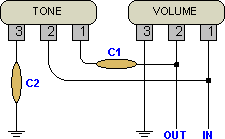
5F2-A Layout
5F2-A Tone Control Schematic
Moonlight
Here is Simcha Delft’s Moonlight tone control. I like this much more than the basic Fender Tweed Champ style single-knob tone control. The tone & volume knobs are more independent of each other, and it’s not as bright as the standard Tweed circuit is. Presented below are the schematic, and a layout diagram for building the tone control on a push-pull pot to include DPDT bypass. Insertion loss is relatively low (at least compared to a standard 3-knob tone stack).
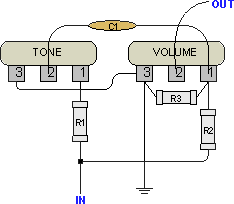
Moonlight Layout
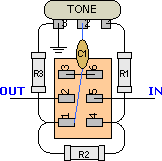
Moonlight Tone Control push/pull layout with Bypass
Moonlight Tone Control Schematic
Garnet
This cool little circuit was posted by Bruce McCabe on the AX84 BBS, lifted from an old Garnet amp. With the tone pot placed in a local feedback loop, it should have a wide range of control.
It also came up again in a thread on low-insertion loss tone controls. Sean K. has built built a variation using a rotary switch to change capacitor values. That should provide a lot of tonal possibilities with a simple circuit and low insertion loss. This would be an interesting tone control to try in the Micro Champ.
The Gibson GA-30RVT also uses this tone control on both of its channels.
18 Watt
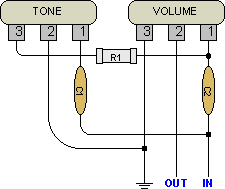
Marshall 18 Watt Tone Control Layout
Marshall 18 Watt Tone Control Schematic
Two-Knob
Fender “Brownface”
Fender “Brownface” amps featured some of their most interesting circuits, IMHO. In between the tweed & the blackface amps, the Champs, Princetons, and Deluxes had Tweed-style single knob tone controls. The Brownface Pro and Bandmaster had a two knob treble/bass tone stack which is somewhat different than the 2-knob variation of the Fender blackface tone stack.
The 350K pot tapped at 70K used by the 6G5-A is available again from Weber.
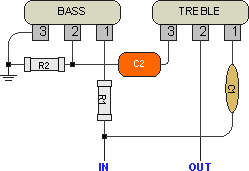
Fender Pro 6G5 or 6G7 tone stack layout
Fender Pro 6G5 or 6G7 tone stack
NOTE: The 6G5 uses a de-coupling cap (0.05uF) inbetween the plate of the preceding triode stage and the tone stack, while the 6G5-A does not. The 6G5-A variation is also used on the Normal channel of the 6G6 Blonde Bassman (and 6G6-A) while the Bass channel has what looks like a Blackface tonestack with only a Bass knob, and the6G12 Concert.
Blonde Twin
From about the same era as the Brownface amps is the Fender Blonde Twin, which has a tone stack very similar to the Baxandall stack. In fact, the only difference really is with the treble pot.
Fender 6G8 tone stack
Baxandall
The Baxandall tone stack (also known as James) is a classic circuit more commonly found in hi-fi designs. I’ve used it with pleasing results in 3 amps now. It’s also been used in some commercial guitar amps, such as the Orange 120 MKII. Magnatone used it in a whole series of amps – the 260-A, M10-A, 460, and 480. Some of Ampeg’s Portaflex amps (e.g. B-15-NF) use it as well. This tone stack is featured in Duncan Amp’s Tone Stack Calculator in slightly modified form under the name “James”. Insertion loss is lower than the standard Fender tone stack, but obviously higher than 1 knob controls.
Here's an in-depth analysis of it.
Presented below are the schematic and 2 layout diagrams. The first is for building the stack on 2 normal pots. The second is for building it on a dual-concentric pot.
In the final revision of the Lunch Box, this tone stack is driven by an IRF820 MOSFET source follower. Like a tube cathode follower, the source follower lowers the driving impedance to drive the tone stack with less signal loss. For more, see Mike Donovan’s article on High Voltage Solid-State Circuits for Guitar Amplifiers, or R.G. Keen’sMOSFET Follies.
General consensus seems to be that’s very flexible, but tends to work better in low-gain amps (not surprising, given how popular it is in hi-fi designs).

Layout on 2 Standard Pots
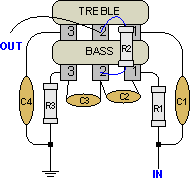
Layout on a single dual-concentric pot
Passive Baxandall Tone Stack Schematic
Baxandall Mid Boost
I had an unused space for another switch on the front panel, so I added a tiny modification to change the frequency response of the tone stack. It simply parallels a 560pF capacitor with the 330pF treble cap. The effect of this is to add a pronounced midrange “hump” with the tone controls flat, and a lessening of the scoop with both controls all the way up. It’s a very simple and effective mod that gives you another distinct sound with only two more components.
The effect is centered around 250-450 Hz, depending on the position of the controls. By additionally paralleling another 180K resistor to make 90K between the Bass & Treble pots you can change that to 300-700 Hz.
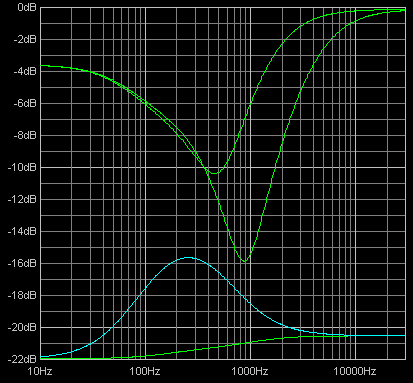
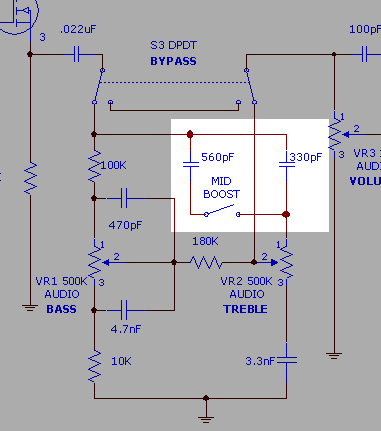
Three Knob
Fender/Marshall/Vox
This is the classic 3 knob tone stack used (in assorted variations) in so many classic amps. Tried and true, it has fairly high gain loss and big mid scoop. Like any tone stack, its response characteristics can be drastically altered with differing impedances and component values. This is simulated in Duncan Amps’ Tone Stack Calculator.
There are numerous minor variations to this circuit. Some leave out the Mid control, replacing it with a fixed resistor. In others, C3 is wired to the wiper of the Mid control, which is wired as a voltage divider instead of a variable resistor.

Basic Tone Stack Layout
Basic Tone Stack Schematic
Dumble
The Dumble tone stack is basically an Fender/Marshall tone stack with lots of switches added which shift the frequency response in various ways.
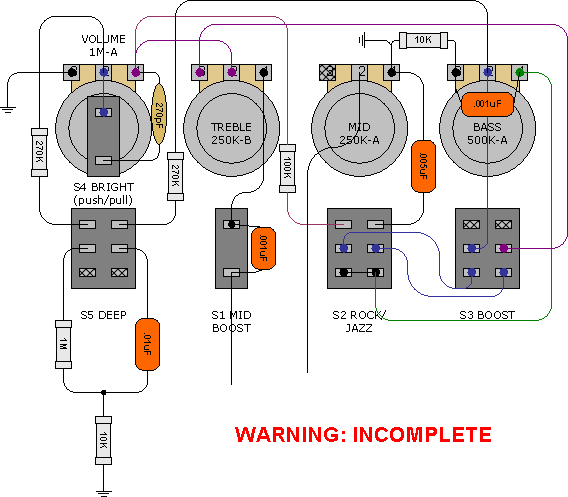
Other
Here’s a link to an excerpt from the RCA Receiving Tube Manual. Web-ified by Stephen Keller, it’s a more complicated tone circuit spread out across two triode stages. It looks like it has lots of possibilities.
This AMZ Presence Control by Jack Orman also looks very interesting. It’s a variation of the Big Muff tone control with some improvements. It has the capability of achieving a flat frequency response as well as a wide variety of bass & treble boost & cut.
A one knob control submitted by Andy Fuchs to an Ampage thread.